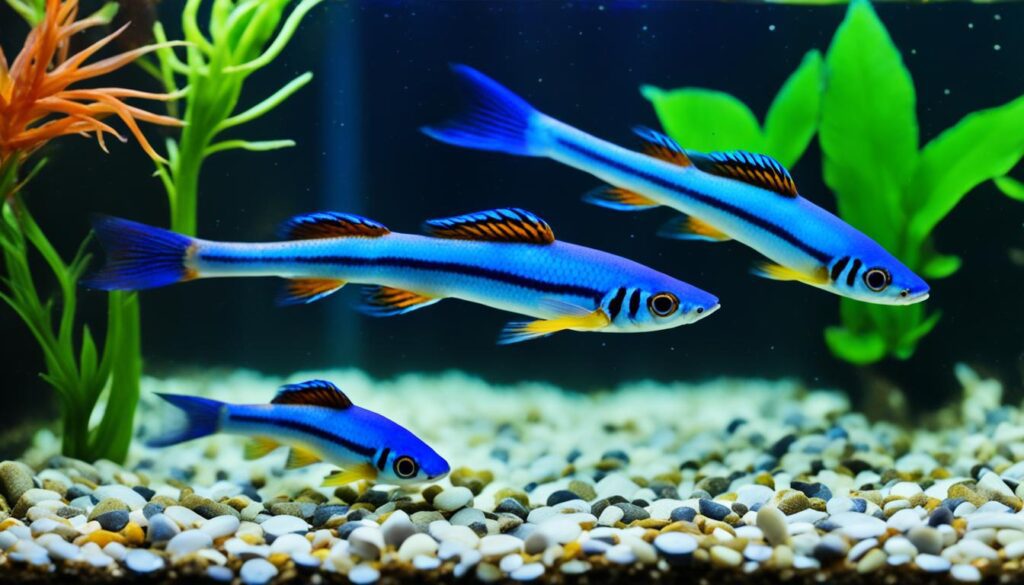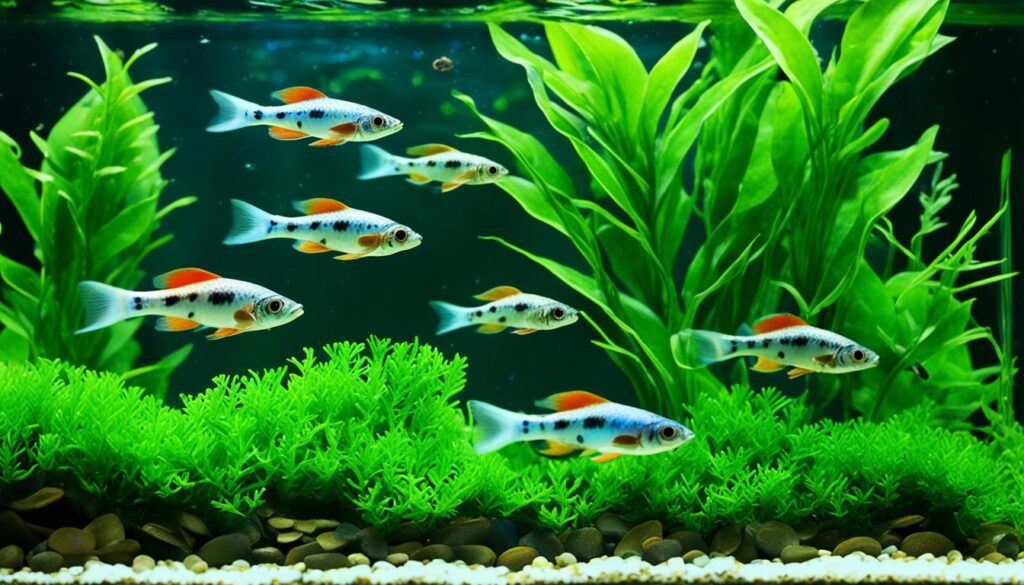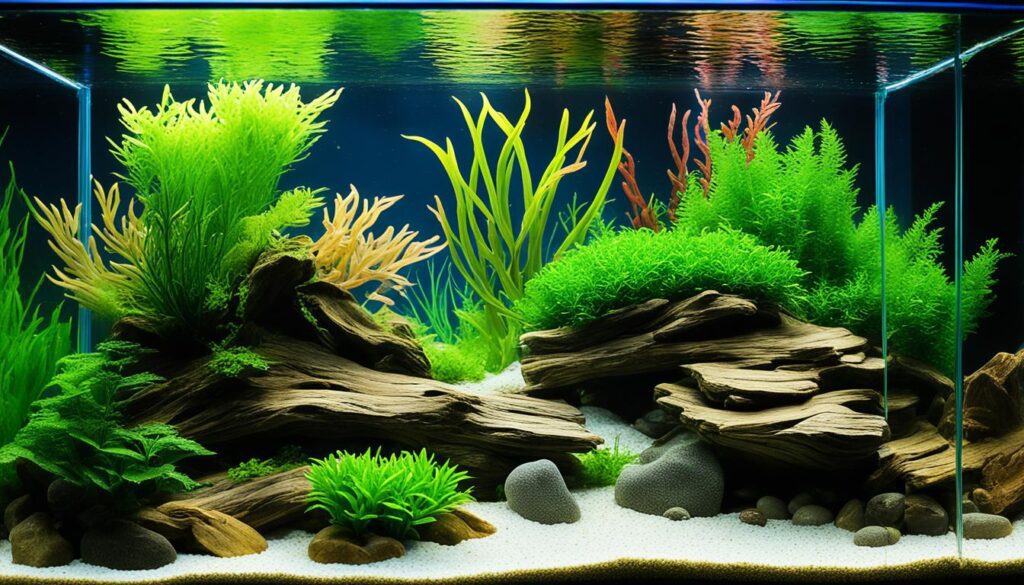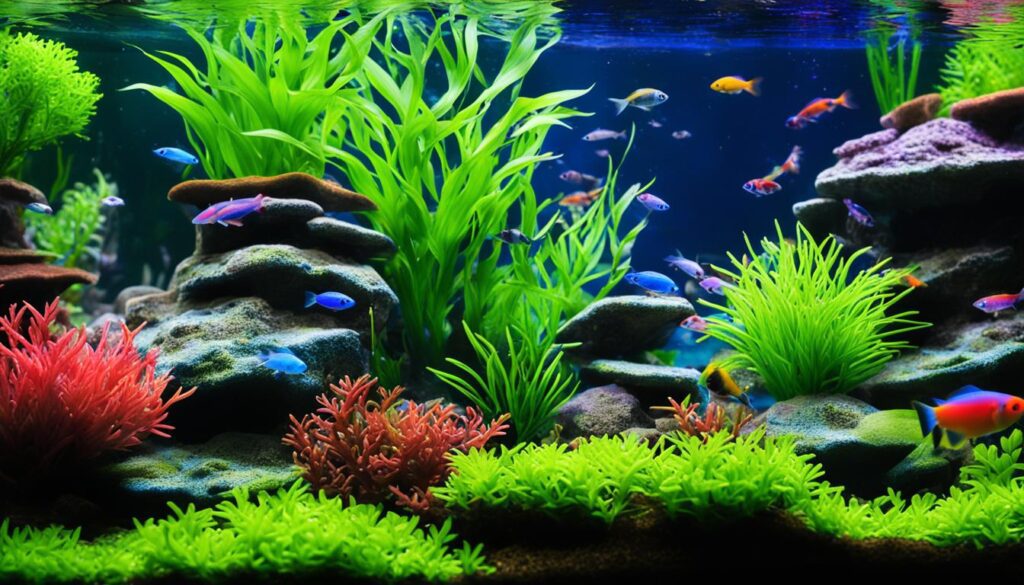The Celestial Pearl Danio (CPD) is perfect for a nano fish aquarium. It stands out with patterns that remind us of a starry night sky. Known as the galaxy rasbora, this small fish grows to 0.75 to 1 inch.
Proper Celestial Pearl Danio care increases their lifespan, which is three to five years. Good galaxy rasbora habitat conditions and a balanced diet are key. Feeding them micro worms, baby brine shrimp, and finely crushed flakes is beneficial to their health.
Effective CPD breeding tips include creating an environment like their home in Myanmar and northern Thailand. A 10-gallon tank is ideal for starting. This size allows a small group to display natural behavior. Keep the tank warm, between 72-76°F. The water’s pH should be 6.6-8.0. Add fine-leaved plants like java moss for spawning.
Introduction to Celestial Pearl Danio (CPD)

I love freshwater aquariums, and I’ve found a stunning fish called the Celestial Pearl Danio, or Danio margaritatus. This tiny fish has an amazing pattern and is perfect for peaceful, small tanks.
Origin and Distinctive Appearance
The Celestial Pearl Danio comes from quiet waters in Southeast Asia, like Myanmar and northern Thailand. They love places that feel like home, with lots of plants. These fish have dark blue bodies with beautiful golden spots and fins that are red, orange, and black.
During breeding season, the males become even more vibrant. They show off with brighter blue colors and a glowing red belly, making them stand out in any aquarium.
Popularity Among Aquarists
This fish is more than just pretty. It’s great for small tanks with lots of plants. These settings remind them of their natural home in Southeast Asia and make them feel safe.
Fish lovers appreciate the Celestial Pearl Danio for its calm behavior. They might chase each other a bit, especially when breeding or sorting out their group order. This makes them interesting to watch in a tank with other fish.
People really enjoy these small, beautifully decorated fish. They have become highly valued in home aquariums, making Danio margaritatus a true treasure in freshwater collections.
The Enchanting Size and Lifespan of Celestial Pearl Danios

Celestial Pearl Danios are a big hit in small aquariums. They are loved for their bright colors, small size, and long life. These tiny fish fit perfectly in small tanks. And they make the tank look better without needing much space. Let’s look at their size, how long they live, and what they need to live long and happy lives.
A Diminutive Size in the Aquarium World
The size of the Celestial Pearl Danio is really something special. They can grow up to 1 inch long. This makes them ideal for small aquariums. They like being with at least 5 others of their kind. This makes them feel safe and lets them act naturally. It also makes your tank look more lively.
Expected Longevity for a Healthy CPD
With the right care, Celestial Pearl Danios can live up to 5 years. For a small fish, that’s a long time. Their life span depends on how well we take care of them. This includes the water’s temperature, its pH level, and the general conditions of their tank. They do well in water that’s 64 to 79°F and has a pH of 6.5 to 7.5. Keeping their water clean and feeding them a good diet is key.
Knowing about their size and lifespan helps us take better care of Celestial Pearl Danios. This makes life better for these tiny creatures. If you’re experienced or just starting, these fish offer an exciting peek into the world of small fish and aquarium care.
Creating the Perfect Habitat: Tank Setup for Celestial Pearl Danios

To create a great home for Celestial Pearl Danios, you need to understand their needs. They thrive in environments similar to their natural homes in Southeast Asia. These are usually calm and full of plants. Setting up my aquarium the right way helped my CPDs do more than just survive; they really thrived.
Starting with a tank that holds 10-20 gallons of water is best. This size allows the small fish to behave naturally in groups. Keep the water cooler, between 72-76°F, to match their home streams’ temperature. The water should also have a pH level of 6.6 to 8.0. Soft to moderate water hardness is best.
Aquatic Plants for CPDs: To make the tank look like their natural environment, I add lots of plants. Plants like Java fern, bacopa, and elodea are not just pretty. They offer CPDs places to hide and reduce stress. They also keep the water clean and provide food for the fish.
Decor and Shelter: Adding driftwood and rocks creates hiding spots and makes the tank more interesting. This setup looks like the rocky streams and areas with submerged wood where they come from. It makes the environment better for these active fish.
By making your tank similar to a CPD’s natural habitat, you improve their life significantly. A well-planned tank shows off their beautiful colors and interesting behaviors. Remember, the right habitat is key to keeping your CPDs healthy and happy.
Care and Maintenance: Ensuring CPD Wellness

Keeping Celestial Pearl Danios (CPDs) healthy and vibrant takes a whole care approach. This means watching their living space and what they eat. As beautiful, delicate fish, CPDs do best in places like their natural home. This part will show you how to take care of Celestial Pearl Danios, helping these lovely fish stay well in your tank.
Optimal Water Parameters for CPDs
To make the perfect aquarium for CPDs, you need to manage several things carefully. For these fish, the quality of water is very important. They need the water temperature to be between 73 and 79 degrees Fahrenheit. For both pH levels and water hardness, keep them between 6.5 and 7.5, and 1 to 5 dGH, respectively. By regularly checking and adjusting these, your CPDs will stay healthy.
Dietary Needs and Feeding Tips for CPDs
Feeding CPDs right is key for their long life and bright colors. As omnivores, they like a varied diet of live, frozen, and flake foods. It’s important to feed them just enough, without overfeeding. Give them small meals two to three times a day. Here’s a list of foods they love:
- Baby brine shrimp
- Frozen cyclops
- Daphnia
- Micro worms
- Crushed flakes
Always remove any food left in the tank after feeding. This helps keep the water clean and stops health problems.
Parameter |
Optimal Range |
|---|---|
Temperature |
73-79°F |
pH Level |
6.5-7.5 |
Water Hardness |
1-5 dGH |
Following these tips for the right tank conditions and a good diet will make a strong base for your CPDs’ health. Remember, being consistent with care is the secret to keeping these stunning fish healthy.
Community and Companionship: Tank Mates for Celestial Pearl Danios

Finding the right CPD tank mates is key for a happy tank. Celestial Pearl Danios (CPDs) are small, peaceful nano fish. They do well with fish that are calm like they are. Good choices are those who get along in a Celestial Pearl Danio compatibility space.
Here’s a guide to the best CPD tank mates for a calm and happy tank:
- Small Tetras: They’re peaceful and make great company for CPDs in shared tanks.
- Corydoras Catfish: These bottom-dwellers are peaceful and don’t bother CPDs swimming above.
- Kuhli Loaches: Kuhli Loaches live well with CPDs without causing disturbances.
- Cherry Shrimp and Snails: These creatures add variety and pose no risk to CPDs.
Avoid big and aggressive fish like Oscars and cichlids. They can scare or hurt the small CPDs. Choose community fish that are peaceful and similar in size to CPDs.
Compatible Tank Mate |
Benefits to CPDs |
|---|---|
Small Tetras |
Similar size and gentle nature make for safe groups |
Corydoras Catfish |
Gentle bottom dwellers, leaving the mid-water for CPDs |
Kuhli Loaches |
Shy and hidden, they keep the tank balanced |
Cherry Shrimp |
They add variety without threatening CPDs |
To have a healthy tank, more is needed than just the right fish. Keeping the right number of fish, stable temperature, and plants matters a lot. This helps Celestial Pearl Danio compatibility in a community tank. You can find more tips on setting up the perfect home for these peaceful nano fish here.
Celestial Pearl Danio Breeding Guide
If you love the small but bright Celestial Pearl Danio, breeding them is as exciting as their colors. Watching these tiny fish, no bigger than 1 inch, thrive in a tank is amazing. I’ll guide you through breeding Celestial Pearl Danios with helpful tips from my experience.
Sexual Dimorphism and Mating Behaviors
Figuring out which are males and which are females goes beyond their shape. Males have brighter colors, while females are rounder. The mating dance in a 20-gallon tank, ideal for 10–15 fish, is fascinating. Since CPDs are not monogamous and mate with many partners, a ratio of two or three females per male works best. This lowers stress and improves chances for breeding.
Creating a Conducive Breeding Environment
Mimicking their natural environment is crucial for successful breeding. I use a 12x10x8 Optiwhite Nano Tank with an AquaEl Air Pump 100 and a Hydor Mini Heater 15W. These maintain a stable temperature of 72–76°F, perfect for breeding. A Moss mat offers an ideal place for spawning. An Ocean Free Bio-Foam Filter 100, set up with bacteria from another tank, keeps the water clean without creating strong currents harmful to eggs and fry. Before breeding, I feed the females high-protein foods to prepare them for egg-laying.
Caring for CPD Fry: Diet and Growth
Protecting CPD fry starts with ensuring they have hiding spots to avoid predators and find food. They eat infusoria and tiny fry food from 5-50 microns initially. Three to four days post-hatching, I introduce baby brine shrimp to their diet. High survival rates for the fry depend on their diet and a safe breeding setup. Keeping a calm tank is key, as male competition can cause stress. This stress can upset the breeding environment for the fish.








